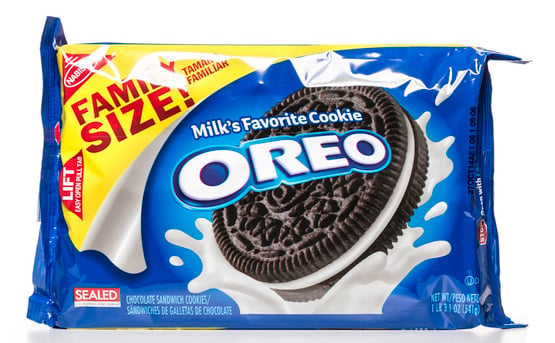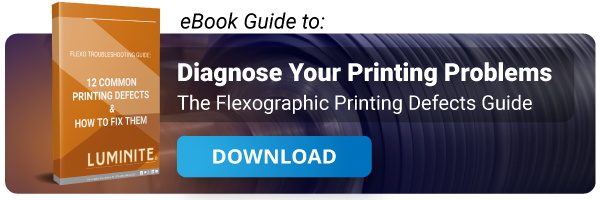Share this
Common Adhesive Printing Applications
by Luminite on Mar 5, 2019 11:07:14 AM
Editor's Note: This blog was originally published on September 1st, 2017 but was updated on March 4th, 2019 to reflect modern information and industry changes.

Adhesive printing has many applications. You’ll often find examples sitting on the shelves of your local supermarket or drugstore.
You buy a bottle of pain reliever. You peel back its sticky label to read the instructions, drug facts, and warnings. Another time you peel the paper coating to a foil blister pack of an over-the-counter allergy medication.
7 Common Applications for Adhesive Printing
The label, paper coating, and the foil lidding? That’s right, they’re all bonded to the packaging with adhesive. Some other common applications for adhesive printing include:
- Product labels (sometimes multiple, folding layers)
- Warning labels
- Shipping labels
- Price/barcode labels
- Stamps
- Tape backing
- Resealable packaging (think Oreo cookies)
- And more
Those adhesive elements are rolled, or printed, to label and securely air seal many consumer products we use daily, especially in the medical and pharmaceutical professions. You’ll need an experienced flexographic printing plate and sleeve manufacturer for products that best suit your choices of adhesive, substrate, and other specs.
What Are You Trying To Accomplish?
First, determine your application. What will a successful adhesive print entail for the job it’s supposed to do?
- Will you need spaces where adhesive is selectively and repetitively not applied to the substrate?
- Will one element be peeled off and affixed to another?
- Is the adhesive intended to be permanent, temporary, or somewhere in between?
- Do you require hot- or cold-processed adhesive, water-based adhesive, or silicone-release coating?
Adhesives react differently with different types of substrates. Some are best to stick labels permanently to corrugated packaging. Others temporarily bond medical labels to be peeled and reapplied to patient files. The applications are nearly limitless.
Environment Impacts Permanent Adhesion
Permanent adhesive power could fade with certain variable conditions:
- Temperature
- Humidity
- Condensation
- Light exposure
Think ahead. Analyze and understand the purpose.
- If the product will be stored in a freezer, how will the adhesive hold up for extended periods under those extreme conditions?
- Will it need to be more powerful and long lasting to withstand outdoor elements?
- Will humidity or condensation compromise the bond?
An adhesive bonding warning label to a gas-powered lawnmower, for example, would need to hold strong in rain, dry spells, heat, and cold for perhaps 10 years or more.
You may need to lay the adhesive in specific continuous patterns to fulfill the job. If your printing sleeve or plate isn’t crafted to specifications, it may not spread enough (or any) adhesive to parts of the substrate, causing it to eventually lift and come loose.
Jobs When Temporary Adhesion is Best
Less adhesive power is sometimes necessary. It may be important for the end user to remove a label. If so, is removing it easy? Would it be unsightly or inconvenient for adhesive residue or full pieces of the label to remain?
Products for which less adhesive power is best include:
- Personal tech device labels
- Household appliances labels
- Fresh grocery produce stickers
- Resealable food packaging
- Tamper-proof seals
- Tape
- And more
No matter the application, choose an experienced flexographic printing supplies manufacturer with the right technology to create engraved sleeves, cylinders, and plates to lay continuous, seamless adhesive.
Share this
- Flexographic Printing (81)
- Image Carrier (28)
- Elastomer sleeves (27)
- Ink Transfer (25)
- Quality (22)
- Flexo sleeve (20)
- News (18)
- printing defects (18)
- flexo printing defects (17)
- sustainability (13)
- Flexo Troubleshooting (12)
- Ink (12)
- Digital Printing (10)
- Flexo 101 (10)
- Flexo Inks, (9)
- Anilox (7)
- Blister Packaging (7)
- Cost (6)
- print misregistration (6)
- regulations (6)
- Corrugated Printing (4)
- pinholing (4)
- "Tradeshow (3)
- Digital Flexo (3)
- Gravure Printing (3)
- Insider (3)
- Load-N-Lok (3)
- Wide Web (3)
- direct laser engraving (3)
- flexo-equipment-accessories (3)
- gear marks (3)
- halo (3)
- testing (3)
- Narrow Web (2)
- bridging (2)
- feathering (2)
- filling in (2)
- mottled image (2)
- pressure (2)
- Labelexpo (1)
- dirty prints (1)
- doughnuts (1)
- embossing (1)
- kiss impression (1)
- October 2023 (2)
- September 2023 (1)
- August 2023 (1)
- July 2023 (3)
- June 2023 (1)
- May 2023 (5)
- April 2023 (1)
- March 2023 (2)
- February 2023 (1)
- January 2023 (3)
- December 2022 (1)
- October 2022 (3)
- September 2022 (2)
- August 2022 (2)
- July 2022 (3)
- May 2022 (1)
- April 2022 (4)
- March 2022 (2)
- February 2022 (5)
- January 2022 (7)
- December 2021 (1)
- November 2021 (3)
- October 2021 (2)
- September 2021 (1)
- August 2021 (1)
- July 2021 (3)
- June 2021 (1)
- May 2021 (4)
- April 2021 (4)
- March 2021 (4)
- February 2021 (2)
- December 2020 (1)
- November 2020 (1)
- October 2020 (2)
- September 2020 (1)
- August 2020 (3)
- July 2020 (2)
- June 2020 (3)
- May 2020 (1)
- April 2020 (1)
- November 2019 (3)
- October 2019 (1)
- August 2019 (1)
- July 2019 (1)
- April 2019 (1)
- March 2019 (1)
- January 2019 (1)
- October 2018 (2)
- August 2018 (1)
- July 2018 (1)
- June 2018 (1)
- February 2018 (2)
- October 2017 (1)
- September 2017 (2)
- January 2016 (1)
- February 2015 (1)
- January 2015 (1)
- December 2014 (2)
- September 2014 (1)
- February 2014 (1)
- January 2014 (1)
- December 2013 (3)
- October 2013 (1)
- September 2013 (1)
- June 2013 (1)
- January 2013 (1)


Comments (1)